|
|
|
Spring. While the steel
framework begins to rise at the Flushing Meadows site of the
Federal Pavilion for the 1964-1965 New York World's Fair, the
Commerce Department issues their final report on Federal participation
at the 1962 Seattle World's Fair. They conclude that construction
of a permanent pavilion rather than a temporary exhibit hall
has many benefits. Indeed, the U.S. Science Pavilion of the Seattle
Fair is about to become the Pacific Science Center --
the crown jewel of Seattle's restored World's Fair site.
|
U.S. Science Exhibit,
Seattle World's Fair, Final Report, March_15, 1963
| "One of the
great permanent benefits of the U.S. Science Exhibit [at the
Seattle World's Fair] was the Pavilion, which ... cost only slightly
more than a temporary structure. Since there are so many worthy
purposes which can be aided by permanent construction, it seems
folly to waste money on temporary exhibit buildings of no residual
value. It is strongly recommended that careful consideration
should be given in the future to the advantages of a permanent
exhibit structure." |
|
|
|
| Summer. The "Mayor's
Committee" submits a recommendation suggesting which World's
Fair structures should remain in Post-Fair Flushing Meadows Park.
They are bound by a guideline that says "buildings not
useful for Park or closely related purposes do not belong in
Flushing Meadow." The Federal Pavilion is not
on their list. |
Post-Fair Engineering Report -
July 25, 1965
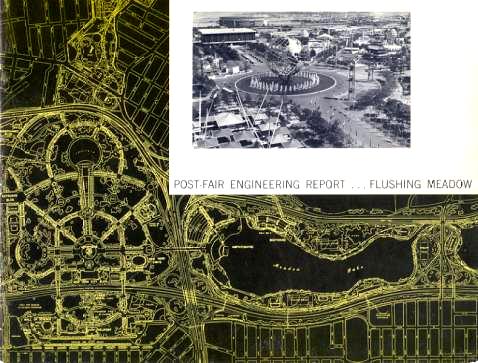 |
-
"The Mayor's
Committee" recommends these structures for retention in
Post-Fair
-
Flushing Meadows
Park
- PERMANENT BUILDINGS FROM THE
1939-1940 WORLD'S FAIR
- The City Building
- The State Amphitheater
- The Boathouse
- BUILDINGS BUILT BY THE CITY
OR FAIR FOR THE 1964-1965 WORLD'S FAIR
- The Hall of Science
- The Administration Building
of the Queens Botanical Garden
- The Singer Bowl
- The Administration Building
- The Post Office Building
- The Entrance Building
- The Maintenance Building
- The Press Building
- BUILDINGS BUILT BY EXHIBITORS
- The Unisphere
- The Heliport
- The World's Fair Marina
- The New York State Building
- The Greyhound Building
- The Ferris Wheel
- The Japanese Wall
|
|
|
|
| Summer. A restored Flushing
Meadows Corona Park is returned to the City of New York following
demolition of the Fair. The Federal Pavilion survives the wreckers.
The U.S. has built the pavilion as a permanent structure, driving
2,300 piles into the old marshland of Flushing Meadows to insure
a stable building that will last indefinitely (engineering studies
a decade from now will indicate the structure is "solid
and stable"). Although the building has no tenant, residual
use for a $10 million, fully equiped structure can certainly
be found. The exhibits have been removed but the building hasn't
changed much otherwise since the day the Fair closed. Display
cases, auditorium seats, movie screens and other fixtures remain
undisturbed. Interestingly, the Federal Government retains the
title to the building while other remaining World's Fair structures
have been donated to the City and Parks Department. |
The Federal Pavilion in the restored
Flushing Meadows Corona Park in June, 1967
|
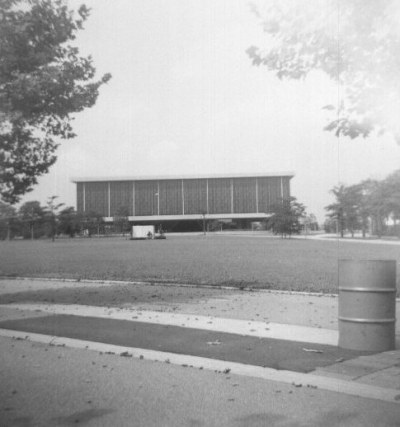
SOURCE: Copyright 2001,
Charles Aybar, Ph.D., All Rights Reserved
|
|
|
|
| Summer. It was hoped that
the former Federal Pavilion would be converted to a community
college or some sort of cultural or recreational facility for
Flushing Meadows Corona Park by now. But all plans have failed
due to lack of financing. The old pavilion has been vacant for
nearly six years but remains in remarkably good condition. |
Inside the Federal
Pavilion, Summer 1971
|
"Back
in the summer of 1971, the operator of the renovated NYS Pavilion
(then converted into a roller rink), in which I worked, applied
for and received a permit to remove some fixtures from the Federal
Pavilion. I accompanied him on his mission. While in the building
we decided to have a look around.
Since there
was no fencing then around the building access was gained through
one of the glass entrance doors (Hall of Education) on the second
level. This door was opened most of the time! Inside the building
all the lights were off, but being an electrician, the boss found
several power panels and started turning the breakers on -- lighting
the whole place up.
We explored
several areas of the building, which was intact. One room was
a beautiful auditorium which had these superb benches made of
solid maple and covered with baby blue leather cushions on top.
There were about 50 or more of these 2' x 12' seats -- all looking
spanking new! These were the fixtures my boss had received the
permit to remove.
There was
also a full, stainless steel kitchen nearby, complete with ovens,
pots, sinks and then -- an Amana Radar Range (microwave oven)
which I had never seen before. The place looked like it was ready
to cook a meal for an army.
We found a
door that led us between a wall and the infamous green fiberglass
panels of the pavilion. This space had all the back lighting
for these panels and were all lit up thanks to the boss. We were
able to walk the length of this space.
We removed
the benches, turned off the lights and left the pavilion behind.
Those benches may still be in the NYS pavilion storage for all
I know.
On another
occasion I had the opportunity to go down to the electrical room
(located underneath the fountains). The sight of the power transformers
was overwhelming. PVC was leaking everywhere from these big black
boxes and the smell was terrible. It looked like liquid tar blasting
out of a volcano. I was surprised that these boxes didn't blow
up."
-- Charles
Aybar, Ph.D.
|
| It is the early 70s and economic
conditions in the country have taken a down-turn. New York (along
with other major U.S. cities) faces a financial crises the likes
of which it has never seen that will eventually lead to near
bankruptcy. The effect on the Park is devastating. |
|
|
|
Recollections
of the U.S. Pavilion
|
"At times,
in the early seventies, we would find and enter through a fence
opening. At a distance the building would look ominous, forlorn.
As one approached, it became even more so. It sat unused, lonely,
abused, haunting as it loomed before us. Yet it retained some
of the glamour it once wore during its functional time. The once
very luminous fiberglass panels were becoming faded through neglect;
some broken by vandals. The remnants of the U.S. Seal shown in
shadow on its mount. Most of the lettering at the top of the
structure remained, though some had fallen through the ravages
of time. The once manicured landscaping was now growing amok.
A sad sight indeed.
Inside the
building the sights and smells made the exterior look beautiful.
Escalators totally vandalized. Anything not nailed down, and
some nailed down, was stolen or smashed. The interior was dark
as coal at night. We had our flashlights. The building was not
without human habitation. Discarded liquor bottles, beer bottles,
spray paint cans were scattered about, as were a variety of condom
packs and syringes. Other than the wisp of the outside wind and
a stray pigeon the silence was deafening. Auditoriums and display
areas sat silent in the littered darkness. The musty air hung
heavily. Every now and then the sound of a drop of water hitting
the floor from a leak somewhere. Voices would echo from the emptiness
all around. There was also evidence of some of the City's homeless
making this their temporary address. In the interior court a
tree still grew in the middle of the many steps.
As solid as
it was it seemed doubtful there would be a future for this beautiful
structure. Ideas had been proposed but seemed to have been as
abandoned as the structure itself. Sadly, in the end, this magnificent
structure met its fate. A very sad post-Fair script indeed. There
was promise; but no visionaries in the City. They simply didn't
care."
--Ken Thalheimer
|
| Summer. Flushing Meadows Corona
Park is suffering from the city's cash crisis. Park maintenance
is at a minimum. There is barely enough money to mow the grass
let alone to keep personnel available to tend to old World's
Fair pavilions. Construction has been halted on the Hall of Science
expansion and the concrete foundation has been fenced off. The
roof has been removed from the abandoned New York State Pavilion
because lack of maintenance has caused some of the multi-colored
fiberglass panels to detach and blow off in the wind, creating
a public hazard. The Federal Pavilion has sat vacant now for
over a decade. The exterior of the building appears much as it
did ten years ago with only a few loose vari-colored panels and
some graffiti here and there. Forlorn trees still grow in the
huge planters in the courtyard. But inadequate Park security
has allowed the interior of the pavilion to fall prey to vandals.
Access to the building is easy through smashed plate-glass doors.
The multi-million dollar structure has been all but destroyed
on the inside. Holes have been punched through the interior walls
to allow light to enter the darkened building so that drug deals
and prostitution can be transacted more easily. Debris from the
interior along with junk brought in by the derelicts litters
the floors. Now the U.S. Tennis Association announces they will
move their facilities from Forest Hills to Flushing Meadows Corona
Park; an act which proves consequential for the Federal Pavilion
in the year ahead. |
Inside the Federal
Pavilion, Summer 1976
|
"We walk
all the way around the building until we get to the side that
faces up the Court of the States towards Unisphere. On this side
just a few short steps up where the lower courtyard begins is
a large concrete wall about seven or eight feet high and four
or five feet across. On its face you can still see the faint
outline of where a large eagle once was mounted and the letters
above it used to read US Pavilion.
Federal Pavilion,
Summer 1976
|
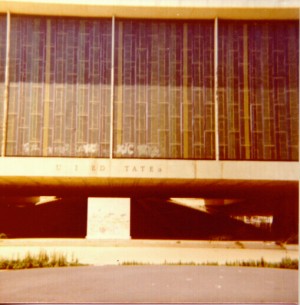
SOURCE: Copyright 2001,
Craig Bavaro, All Rights Reserved
|
The lower
courtyard ceiling seems to be mostly intact although most if
not all of the light bulbs are either broken or gone. There are
two large planters at the top of the stairs on opposite ends
of the courtyard. They still have trees in them, which are obviously
getting water through the roof opening when it rains.
We notice
that all of the glass doors that lead into the building are smashed.
We carefully pick our way through one of them into what seems
like a reception area. It is very dark inside with the only light
coming from the door we just entered through. We can make out
some smashed display cases and over on one wall is what appeared
to have once been plaster letters glued to the wall forming an
expression. The floor is covered with massive amounts of debris
and broken glass.
We then decide
to try another entrance. This space is huge and empty. The concrete
floor is barren of anything. This space is better lit since there
appears to be holes in the outer walls that are letting light
inside here and there. The ceiling is very high and black but
it appears as if at one time some kind of large lighting or machinery
of some type was mounted up there. I can also make out a white
movie screen on one of the far walls. My friend and I run over
to some of the holes where the light is coming in to further
investigate. Some of them are big enough to fit our heads through.
What we see is the outer curtain of multicolored panels that
line the entire outside of the building. In the space between
the outside wall of the building and the panels themselves are
the remnants of light fixtures that once lit the outside of the
building ... they have been ruined beyond salvage at this point.
We then decide
to try one more entrance. Entering the last set of shattered
doors we enter another set of general reception and display areas.
Once again the entire area is in ruins. Lighting fixtures are
hanging from the ceiling and plasterboard has been pulled from
the walls or bashed in right where it hung on the studs. The
floor is littered with a huge amount of interior decor debris
and junk brought in by the vandals. After carefully picking our
way back down through all the rubble ... we finally found our
way back to the courtyard and the sweeping stairs down."
-- Craig Bavaro
Click HERE to read Craig's entire
essay "A World's Fair Odyssey and An Afternoon of Delight"
|
|
|
|
|
"It should
have been kept. Now, it's too late. The only thing to do is tear
it down. I recommend turning the building into a branch of the
Metropolitan Museum of Art. Now it's too late; the vandals have
ruined the building and it should be torn down."
--Robert Moses
DAILY
NEWS, November 11, 1976
|
| Winter. The Federal Pavilion
is demolished. No use is ever found for the building, empty for
11 1/2 years. Its title remains in the hands of the Federal Government
who had recently promised the City they would not turn the building
over to a party other than City or State, for fear a developer
would abandon a project in midstream, leaving the "hulking
white elephant as a neighborhood eyesore." Local groups
fight in vain to save the pavilion at the last minute, arguing
the building is still viable with damage being non-structural
and confined mainly to the interior of the building. Newspaper
reports at the time say it took years for the City to
get the Federal commitment of $530,000 to demolish the building
while the Federal Goverment claims it has tried for years
to get the City to accept the title to the building. Officials
estimated it would cost at least $6 million and possibly $15
million to rehabilitate what was left after years of vandalism.
By mid-March only the steel framework remains. Soon it will be
a grassy circle just as it had been 15 years earlier when President
Kennedy broke ground for the Federal Pavilion at the 1964-1965
New York World's Fair. |
Demolition of the Federal Pavilion,
March 1977
SOURCE: Copyright 2001, Bill
Young, All Rights Reserved
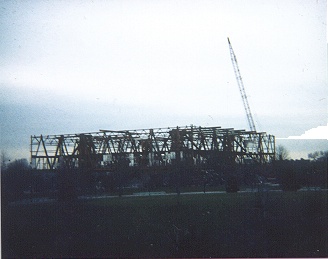 |
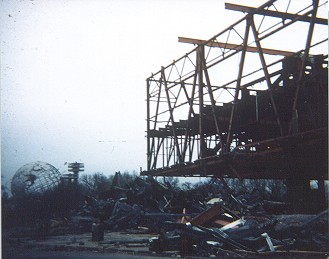 |
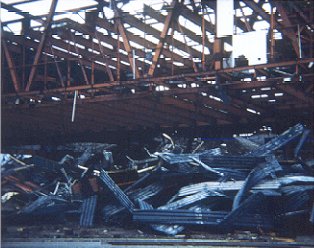 |
|
|
|
|
"Freedom of the Human Spirit"
stands in front of a grassy Kennedy Circle.
|
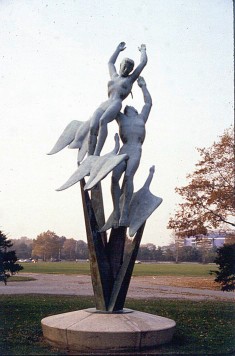
SOURCE: Copyright 1989,
Rich Post, All Rights Reserved
|
| Summer. Much has happened
to the Park in the succeeding 12 years since the Federal Pavilion
was demolished. The city's financial crisis is over and, slowly,
more money is being made available to the Park to correct the
effects of the years of neglect. The Hall of Science expansion
has been completed. The U.S. Tennis Association has made major
renovations to the Fair's Singer Bowl stadium, now renamed
the Louis Armstrong stadium, where the main tennis matches
are played. |
View across Kennedy Circle toward
the Louis Armstrong (Singer Bowl) stadium.
|
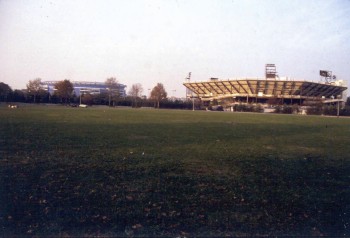
SOURCE: Copyright 1989,
Rich Post, All Rights Reserved
|
|
|
|
| Summer. With Flushing Meadows
playing host to the U.S. Open each September, the eyes of the
world are once again drawn to the Park in the form of major television
coverage. The City of New York wants the cameras to see only
good things when they pan the Park. More money is spent to clean
and restore Unisphere and the old Fair fountains. The U.S. Open
has outgrown Louis Armstrong stadium and a new stadium
is built over the 2,300 piles that were driven to support the
massive Federal Pavilion back in the 60s. It is dedicated in
the name of tennis great Arthur Ashe. |
"Freedom of the Human Spirit"
stands in front of the Arthur Ashe stadium constructed
on the site of the former Federal Pavilion.
|
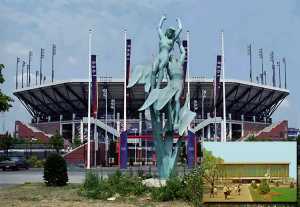
SOURCE: Copyright 1998,
Larry Hubble, All Rights Reserved
|
|
|
|
| The crowds come again to the
area that used to be Kennedy Circle -- to the place where the
Federal Pavilion used to stand -- where a different type of "Challenge
to Greatness" plays out -- each September at the U.S. Open
at Flushing Meadows. |
|
|
Webmasters
note...
The photographs
on this page are the property of, and copyright by, their owners
as indicated. Please DO NOT reprint them without obtaining permission
through this website
Like the New
York State Pavilion feature, the story of the Federal Pavilion
at nywf64.com wouldn't have been possible without contributions
from many people. I'd like to take this opportunity to thank
and acknowledge them for their help: To Charles, Craig and Ken
for writing their excellent recollections of visits to the Federal
Pavilion in the years between the Fair and its demise. To Mary
Ellen Coughlan for the Executive Order and Gary Holmes for the
many Fact Sheets and photos that helped to tell the story of
the planning for the pavilion. To Craig Bavaro for the Report
that is the Fair Corporation's request for the Franklin Center
of Science and Education as Federal participation. It was
an unknown gem! To Bill Cotter for sending those wonderful photos
from Elevator World magazine -- the only pictures I've
ever seen of "The American Journey" moving grandstands
and to Ray Dashner for providing the soundtrack to the ride and
to "Voyage to America" so that the scripts could be
translated. And lastly, to Bruce Mentone, Rich Post, Larry Hubble,
Charles and Craig for the photos that illustrate the Epilogue
section. Thanks to all of you! Together, you've told the grand
story of the Federal participation in the Fair and the sad story
of the pavilion's fate. Your contributions are greatly appreciated.
- Bill Young
- January 21,
2001
|
|